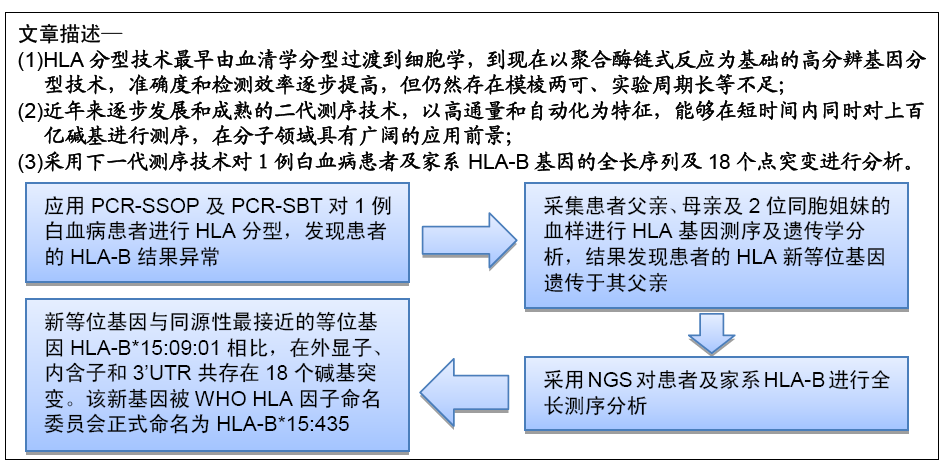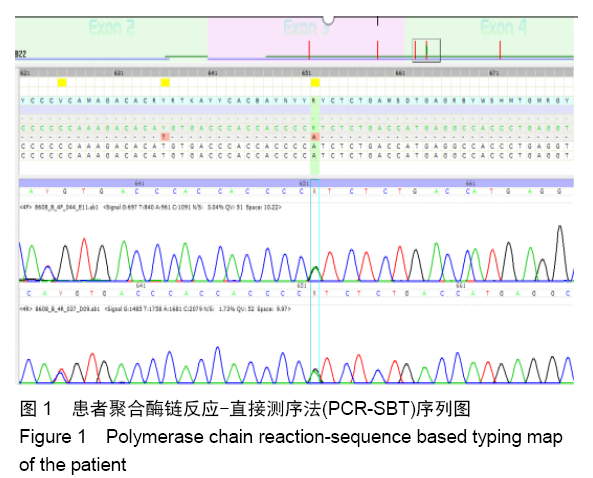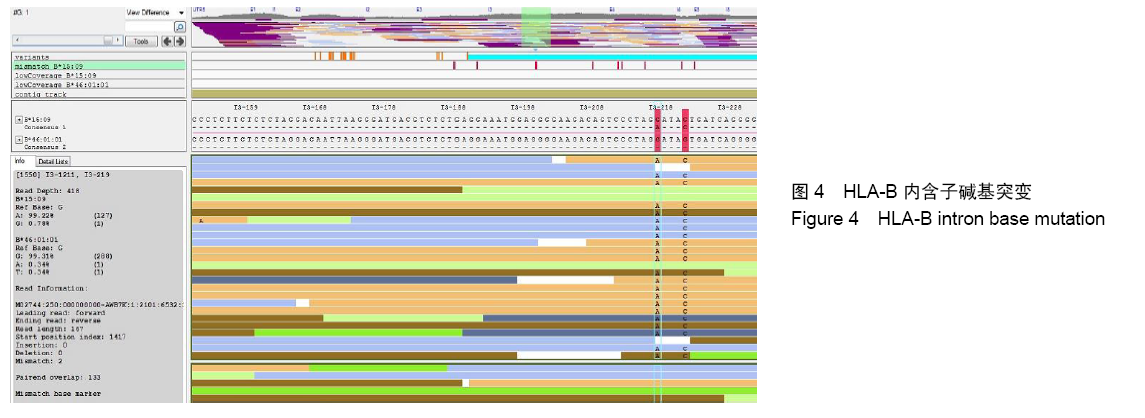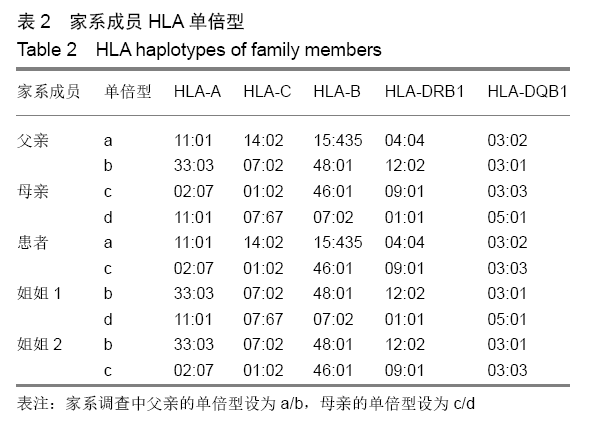[1] SANCHEZ-MAZAS A, NUNES JM, MIDDLETON D, et al. Common and well-documented HLA alleles over all of Europe and within European sub-regions: A catalogue from the European Federation for Immunogenetics. HLA. 2017;89(2):104-113.
[2] HE Y, LI J, MAO W, et al. HLA common and well-documented alleles in China. HLA. 2018;92(4):199-205.
[3] MORISHIMA S, KASHIWASE K, MATSUO K, et al. High-risk HLA alleles for severe acute graft-versus-host disease and mortality in unrelated donor bone marrow transplantation. Haematologica. 2016; 101(4):491-498.
[4] TIERCY JM. HLA-C Incompatibilities in Allogeneic Unrelated Hematopoietic Stem Cell Transplantation. Front Immunol. 2014;5:216.
[5] 欧国进,王珏,刘红露,等. HLA-C基因5'端-35kbT/C多态性对HIV感染进展影响的研究[J].中国输血杂志, 2016, 29(1): 36-38.
[6] 张莹,乔福元,曾万江,等.人类白细胞抗原分型在淋巴细胞主动免疫治疗不明原因复发性流产中的价值研究[J].中国实用妇科与产科杂志, 2016, 32(6):583-587.
[7] KANDA J, SAJI H, FUKUDA T, et al. Related transplantation with HLA-1 Ag mismatch in the GVH direction and HLA-8/8 allele-matched unrelated transplantation: a nationwide retrospective study. Blood. 2012;119(10):2409-2416.
[8] 季碧霞. HLA:从分子到功能[J].国际遗传学杂志,2000,23(1): 36-40.
[9] 曾大勇,王长连,黄品芳,等.福建汉族人群服用别嘌醇引起严重皮肤不良反应与HLA-B* 5801关联性[J].中国医院药学杂志,2015,35(12):1119-1122.
[10] DOCKREE T, HOLLAND CJ, CLEMENT M, et al. CD8+ T-cell specificity is compromised at a defined MHCI/CD8 affinity threshold. Immunol Cell Biol. 2017;95(1):68-76.
[11] SANTOS S, RODRIGUEZ C, EGUIZABAL C, et al. Characterization of the novel HLA-A*80:04 allele identified in a Spanish volunteer donor. HLA. 2018;92(4):245-246.
[12] ELSERMANS V, VISENTIN J, TOP I, et al. Characterization of the novel HLA-DRB1*13:191 allele by sequencing-based typing. HLA. 2019;93(1):55-56.
[13] 裴永峰,黄惠妮,李恒聪,等. HLA新等位基因B*13:92的确认及蛋白质三级结构的初步分析[J].中国实验血液学杂志, 2016, 24(5):1558-1562.
[14] 聂向民.人类白细胞抗原新等位基因A*24:257序列及其编码蛋白分子三维结构模拟分析[J].国际免疫学杂志, 2018,41(4): 367-371.
[15] YANG KL, LIN PY. Detection of a novel HLA-A*11 variant, A*11:292, in a Taiwanese individual. HLA. 2019;93(1):40-41.
[16] VOORTER CE, GERRITSEN KE, GROENEWEG M, et al. The role of gene polymorphism in HLA class I splicing. Int J Immunogenet. 2016; 43(2):65-78.
[17] LADEWIG E, OKAMURA K, FLYNT AS, et al. Discovery of hundreds of mirtrons in mouse and human small RNA data. Genome Res. 2012; 22(9):1634-1645.
[18] CHITNIS N, CLARK PM, KAMOUN M, et al. An Expanded Role for HLA Genes: HLA-B Encodes a microRNA that Regulates IgA and Other Immune Response Transcripts. Front Immunol. 2017;8:583.
[19] 杜冉冉,王师,张火兵,等. HLA-B27与强直性脊柱炎相关性研究进展[J]. 标记免疫分析与临床, 2018, 25(4):589-592.
[20] 张成亮,朱宝林,吴建伟.探讨HLA-B27阳性率、TNF-α、CRP水平检测对强直性脊柱炎的诊断价值[J].中国检验医学与临床,2018,15(7): 999-1001.
[21] DAHMANI CA, BENZAOUI A, AMROUN H, et al. Association of the HLA-B27 antigen and the CTLA4 gene CT60/rs3087243 polymorphism with ankylosing spondylitis in Algerian population: A case-control study. Int J Immunogenet. 2018;45(3):109-117.
[22] 谢彦昕,朱一,吴建茹,等. 中国人群HLA-B基因多态性与HIV关联性的Meta分析[J]. 循证医学,2014,14(2):87-93.
[23] EYIOL A, YAYLA Ç, ÜNLÜ S, et al. Relationship of serum HLA-B alleles and TNF-α with rheumatic heart disease. Turk J Med Sci. 2018;48(4):724-729.
[24] 王东梅,王丽君,倪蕾,等.流式磁珠反向SSOP杂交法误判HLA基因型的原因分析(附4例报告)[J].北京医学, 2012,34(5):384-386.
[25] 高素青,程曦,方卫华,等.流式磁珠反向SSO法HLA分型结果判读影响因素及解决对策的研究[J].中国输血杂志, 2007,20(4): 295-297.
[26] 张容达,杜娟,马晓莉,等. PCR-SSO流式荧光微珠法HLA-A*02高分辨分型检测模棱两可结果的统计分析[J].中国组织工程研究, 2011,15(45): 8483-8486.
[27] 章旭,林凤秋,李剑平.流式磁珠PCR-SSOP法漏检2例HLA-A位点罕见基因型的原因分析[J].中国输血杂志, 2011, 24(4):327-329.
[28] 安仕萍, 闫莉娜. 测序技术在人类白细胞抗原基因分型领域的应用进展[J].医学综述, 2007,13(15):1189-1191.
[29] HOSOMICHI K, SHIINA T, TAJIMA A, et al. The impact of next-generation sequencing technologies on HLA research. J Hum Genet. 2015;60(11):665-673.
[30] GOODWIN S, MCPHERSON JD, MCCOMBIE WR. Coming of age: ten years of next-generation sequencing technologies. Nat Rev Genet. 2016;17(6):333-351. |






